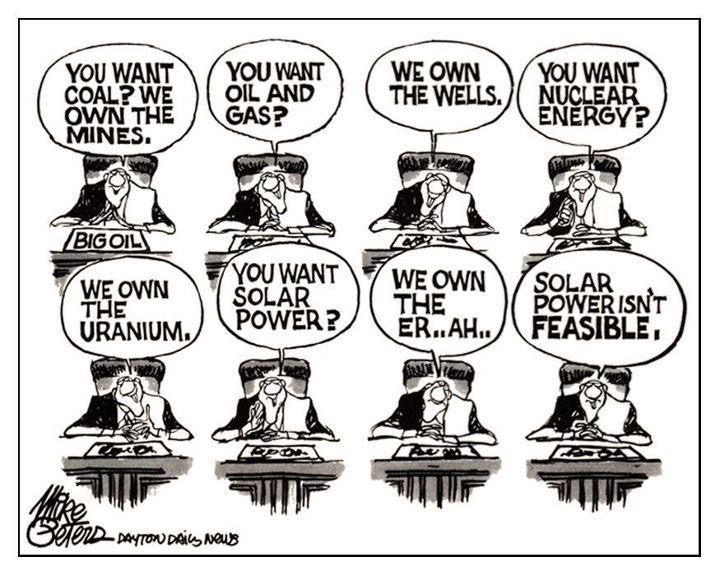- cross-posted to:
- aboringdystopia@lemmy.world
- cross-posted to:
- aboringdystopia@lemmy.world
I saw some context for this, and the short of it is that headline writers want you to hate click on articles.
What the article is actually about is that there’s tons of solar panels now but not enough infrastructure to effectively limit/store/use the power at peak production, and the extra energy in the grid can cause damage. Damage to the extent of people being without power for months.
California had a tax incentive program for solar panels, but not batteries, and because batteries are expensive, they’re in a situation now where so many people put panels on their houses but no batteries to store excess power that they can’t store the power when it surpasses demand, so the state is literally paying companies to run their industrial stoves and stuff just to burn off the excess power to keep the grid from being destroyed.
Lol
I just love when large organizations (governments included) skimp on something for monetary reasons, and get fucked down the line.
Too bad citizens pay the damages.
Wish there was just a faster way to get citizen input.
“Hey folks, this is going to be a cost overrun for this very very good reason, please vote yay or nay in the weekly election”.
Don’t see how it could work now though, given that half the citizens are deeply committed to destroying everything to prove gov doesn’t work.
Batteries are more than likely another type of pollution. I’m sure they can and will be recycled but just like the problem with our current capacity to recycle things it probably becomes untenable (guessing).
The state just needs to find ways to convert that energy into something else. I suggest desalinating sea water and pumping it up stream.
You can’t just say battery. There’s tons of energy storage that isn’t chemical based. Thermal sand batteries, pumping hydro up a hill, flywheel energy storage, etc.
Energy storage doesn’t inherently mean pollution
That’s not what I got from the article. (Link for anyone who wants to check it out.)
My interpretation was that decreasing solar/wind electricity prices slows the adoption of renewables, as it becomes increasingly unlikely that you will fully recoup your initial investment over the lifetime of the panel/turbine.
In my mind, this will likely lead to either (a) renewable energy being (nearly) free to use and exclusively state-funded, or (b) state-regulated price fixing of renewable energy.
Just send the electricity to a neighbouring state. Sure, it’ll be really inefficient to pass it through that massive length of cable, but that’s fine, we don’t care about that. If the interstate power infrastructure doesn’t have enough capacity then first priority should be to upgrade it.
That’s one of the options they mention as a solution.
Basically store it, use it, ship it, subsidize it or pay someone to waste it are the options.
Right now they pay someone to waste it, which is the option that makes adoption the most difficult, so it’s a problem.
America is severly lacking in UHVDC.
The peak of power demand is behind the peak of production. So sending power east makes so much sense.
Also, let’s be real here. The Lion battery farms, defeat any sort of environmental benefit. It is a total shot in the foot, which is why governments, and solar companies don’t advertise the concept.
For a moment I was thinking that lion battery is some brand, until it clicked in that you are talking about lithium ion batteries

We own the factories building the panels.
Solar cells don’t really grow on trees.
Solar cells don’t really grow on trees.

Are you talking about
A scalable self replicating and self sustaining carbon capture technology that uses a mix of highly specialized biological processes to turn CO2 into engineering grade composite construction material, fuel and fertilizer.
?
The first factories were powered by waterwheels. Those were subjected to seasonal variations and limited geographic possibilities, what gave negotiating power to labor. Therefore the industry switched to fossil fuels, so they could run when and where they wanted, preferably near a city with excess labor force. It made it more expensive to run, but it was easier to exploit labor so more profit.
In the case of Spain, at least, they own the grid, so all solar energy that you sell to distributors because you have no use for it yourself, they’ll only pay you peanuts for it and they will still make a devious profit.
The two solar panels companies that I got in contact with weren’t interested in selling me a quantity small enough that was coherent with my needs, and they’d charge me a premium if I wasn’t willing to make a contract with them to sell them specifically the excess energy.
But if you have batteries at home you almost don’t need the grid. Add an EV and you hit two birds with one stone.
i wonder if the battery in an ev can be used as a house battery?
It’s certainly possible, but is it worth it?
EV batteries tend to use some of the best technology available in order to get power density and energy density where they need to be. A house battery can be much bigger and heavier if that makes it cheaper.
Somebody at work was just telling me about some efforts to reuse e.g. Tesla battery packs for home or grid storage rather than recycling them. Even if the pack can only hold 80% of its original charge, that’s fine if you can just buy a few of those cheaply.
My favorite solution for storage of excess power is closed loop pumped hydro. Two bodies of water of different elevations are connected by a generator/pump. When there is too much power, the pump moves the water to the higher lake. When the power is needed, the water flows through the generator to the lower lake.
This is like the gravity generators they’re looking to use old mines for.
If the excess energy cannot be stored, it should be used for something energy intensive like desalination or carbon capture.
Heck pumping water uphill for all I care. The more potential energy the better.
Many places actually do pump water uphill into reservoir lakes for hydroelectric dams. In that case it is a form of energy storage, a literal water battery.
Unfortunately, it’s not always a feasible option. For instance, in the great planes there’s not much of an uphill to pump the water to.
I’ve seen some interesting ideas from Low Tech Magazine - one that I found particularly interesting was flywheel energy storage. Take a heavy disk or drum and spin it up with excess electricity, then discharge the spin from the battery when the Sun goes down.
Or heck, have fun with it. It’s leftover
You mean just juice your veins?
Both of the statements in that screenshot are just so inane.
Frequency has to be maintained on the grid. It’s the sole place where we have to match production and consumption EXACTLY. If there’s no battery or pumped storage storage available to store excess energy, the grid operators have to issue charges to the producers, in line with their contracts, to stop them dumping more onto the grid (increasing the frequency). The producers then start paying others to absorb this energy, often on the interconnectors.
It’s a marketplace that works (but is under HEAVY strain because there’s so much intermittent production coming online). When was the last time you had a device burning out because the frequency was too high?
Turning the electricity grid into some kind of allegory about post-scarcity and the ills of capitalism (when in fact it’s a free market that keeps the grid operating well) is just “I is very smart” from some kid sitting in mom and dads basement.
Your explanation works very well, but completely falls apart in the last paragraph.
Solar power production clearly is (at least in part) a post-scarsity scenario, given we literally have too much power on the grid.
Furthermore, calling the power market anything like “free” is just plain wrong. A liberal approach to market regulation here would have led to disaster a long time ago, for the reasons you described at the beginning of your comment.
The market “works” because of, not inspite of regulation.
And negative prices are a good thing for consumers, not market failure.
But too much power on the grid isn’t “here, have at it”. It’s fried devices and spontaneous fires breaking out. The grid can’t “hold the power”, only pumped and battery storage can, of which we have nowhere near enough. The grid literally cannot work if other producers put more electricity on to it.
If you have smart meter, you can literally be paid to use power at that point.
wait until you figure out how we solve this problem…
wait for it…
You just don’t produce that energy.
lol. Yes, it’s that simple.
A liberal approach to market regulation here would have led to disaster a long time ago, for the reasons you described at the beginning of your comment. The market “works” because of, not inspite of regulation. And negative prices are a good thing for consumers, not market failure.
Regulation of a market by the government is liberal politics. A laize faire approach is conservative lol.
Neo liberalism is the core ideology of modern conservatism. For example, both the republican and democrat parties in the United States adhere to Neo Liberal ideology. They are both conservative.
Neo liberalism is the ideology of deregulated capitalism. Neo liberalism holds that everything should be marketable without government interference, including healthcare, real estate, power generation, water, etc. Pioneered by Margaret Thatcher and Ronald Reagan, it is the dominant political ideology across Western democracies. Liberals and Conservatives are both adherents of Neo Liberal capitalist ideology. Leftists are those who support regulation, they are definitionally anti-capitalist. When people refer to the democrat party as socialist or democrats as Leftists, they’re just misusing those terms. Democrats are Neo liberal conservatives who, by and large, support deregulated capitalism.
Okay, and?? None of that goes against what I said. In the scope of us politics, Deregulation of markets in the US is Republican platform. Regulation of markets is Democrat platform. Democrats in the US are more liberal than Republicans even though, as you said, they are far from real leftists.
Their platform at times advocates regulation, but they don’t do much in the way of it. They are largely still in favor less regulation. We have had Democrat presidents since Reagan, quite a few actually and despite that unilaterally regulation had decreased pretty constantly over that time period.
Frequency has to be maintained, and it is trivial to do so when you have excess renewables because inverters are instantly throttle-able. The reason why you’ve never heard about devices failing because frequency is too high is because it is and has always been such a non issue to shutter unneeded generating capacity.
Typically with fossil fuel plants, when the price drops below the cost of fuel for the least efficient plants they drop offline because they are no longer making a profit on fuel and the price holds. Because renewables have upfront cost to build but are free to run on a day to day basis, when there are a lot of renewables the price signal has to drop all the way to nothing before it is no longer profitable to run them.
All this means that all that happened was that for a few hours, solar production was actually enough to satisfy demand for that region. Along term, if low wholesale prices can be counted on midday then people will build industry, storage, or HVDC transfer capacity to take advantage of it.
If these prices are sustained for enough of the day that it is no longer profitable to add more solar farms, then they will stop being built in that area in favor of was to generate power at night such as wind, hydro, and pumped hydro while the panels will instead go to places that still don’t have enough solar to meet demand.
Also as an aside, the wholesale electricity market in north america is by definition about as far from a free market as it is possible for a free market to be without having exact outside price controls. It is a market built solely out of regulation that only exists at all because the government forced it to exist by making it illegal to not use it, either by making contracts off market or by transmission companies in-houseing production, or use it in any way other than as precisely prescribed by the government.
Now we can argue whether or not the wholesale electricity market is well or poorly set up or even if it should exist in the first place, but I don’t think that anyone can argue that it is a free market. At least not without defining the term free market so broad that even most of the markets in the USSR qualify as free markets.
Also, free markets and capitalism are very distinct concepts with no real relation between each other. You might argue that free markets tend to lead towards a capitalist system, but given free markets existed thousands of years before capitalism was invented I don’t think many people would say it was a very strong relationship.
Isn’t there any kind of economic activity that could make use of this excess energy, even if it isn’t very profitable?
Yes. Desalination or hydrogen separation via electrolysis
Both uses are productive, one generates fresh water, the other can be a form of energy storage.
Both are extremely energy intensive for the yield, making them unprofitable, but are extremely useful things to do with a glut of electricity.
Usually too low frequency is issue, I can’t imagine why even double frequency can damage PSU.
There’s a reason why the frequency is exactly 50hz or 60hz, and it’s not “at least 50hz or 60hz”. You can’t just have 55hz on the grid, you’ll destroy half a country.
Ok, your particular device may handle a wide band of frequencies. Congrats.
But do we agree that not all devices can? What about sensitive devices keeping patients alive in hospitals?
Those would not be plugged straight into the grid but with a power conditioner inbetween
Oh ok, I guess frequency maintenance on the grid isn’t a problem then and all the pumped storage and battery installations can shut and all the grid planners can go home and the spots markets can close and we can just dump as current as we see fit onto the grid and you’re right and I’m wrong.
All of that matters, but I think the parent post was only calling out the hospital equipment as a bad example. Like how your keyboard and your SSD don’t care what the grid is doing as long as the PSU can handle it.
But back to maintaining the frequency on the grid, along with keeping it within tolerance don’t they also have to make sure that the average frequency over time is VERY close to the target? I believe there are devices that use the frequency for timekeeping as well, like some old plug-in alarm clocks.
Fair enough. I was getting frustrated because I was trying to make a larger point about the fact that the grid can’t endlessly handle production. At some point the grid has to say “it will cost you to dump this onto the grid”. And suddenly I found myself discussing PSUs. I mean, yes, I’m aware there’s equipment on the grid that can handle different frequencies better than others but I felt we were discussing the bark of a single tree when I was trying to talk about the forest.
Also fair enough!
It really is a good point you make though. There’s a large balancing act to produce the right amount of power at exactly the time it’s needed. I think in our daily lives, and especially for non-tech/STEM folks, electricity is just taken for granted as always available and unlimited on an individual scale. I think people don’t envision giant spinning turbines when they plug something in, just like they don’t think of racks of computers in a data center when they open Amazon or Facebook.
Maybe it will be less like that in a couple decades when there is distributed energy storage all over the grid, including individual homes & vehicles.
Actually there is a good amount of credible economic theory which backs the idea that localized post-scarcity markets do cause capitalist influences to wither away, and that power generation is a big fucking domino in that equation. The simple version is that maintenance of artificial scarcity is modeled as capital overhead, so there will always be an inflection point where that overhead actually exceeds the value of all other inputs. The same way eg, marketing cannot create infinite or arbitrary demand.
The other angle here is how there is often incentive for alternative commodification of abundance, which in turn incentives that abundance. This is another common model for various forms of post-scarcity capitalism. Take a YouTube video for example. The commodification of content takes the form of advertising, which effectively transfers the scarcity of one market onto another. Content is basically infinite compared to viewership time inputs. The key here is that there will always exist some forms of scarcity - and time is the big one. Art, company, leisure, physical space, etc. the model here is that eventually something like energy and physical resources might be completely abundant and effectively free, but enabled by competition over attention or leisure or aesthetic experience. You can make a strong argument that this is already happening in the post-industrial world to some degree.
The final issue is that this equation isn’t unique to capitalism. Socialism mediates scarcity in more or less the same way - by transferring and meditating it across various markets using labor as the quanta of scarcity instead of capital. Indeed, many economists will argue that regulated, democratic, liberal forms of capitalism theoretically reduces to the same core basis, since “free [as in speech] labor” itself both creates the market regulation as well as provides the consumption which mediates access to capital. This is, in fact, the core thesis of “third way” market socialism, though it is obviously contentious among orthodox Marxists.
To be fair, having a mismatch between when energy is available and when it is needed is going to be a problem under any economic system, since it’s a fundamental inefficiency that must be worked around with additional effort and resources
You gotta recharge your phone battery sometime though - and if electricity had a different cost for nighttime vs. daytime, you can bet that people would choose the day option whenever possible.
(I chose a mobile device here bc it doesn’t need any “extra” battery or technology beyond what would already normally be at hand.)
Most places in the US have peak and off peak hours with different pricing already. Certain smart thermostats can take advantage of this for running your AC and such.
We need natural batteries like solar power lifting water from a lake into a reservoir so that when we need that energy and the sun isn’t making it, released water does
Am I the only one noticing a lot of conservative economic priests in here? Is this normal?
Reactionaries grow louder as the system becomes more strained and workers more class aware.
You’re literally spouting slogans.
The fact that this is a known phenomenon does not make it incorrect, lmao.
<citation required>
Just because you spout slogans doesn’t make you right
Sure, then counter what I said.
Come up with an original non-slogan thought and I will
So you just, what, refuse to make any coherent points other than vague gestures? Sounds about right for you, I guess, but still disappointing.
This is a real problem but you can only have so many words in a tweet. Note that the price isn’t zero but instead negative. It means there is literally too much power in the grid and it would need to be used. If a grid has too much power then it is bad. It can damage it. There are things we can build that essentially amount to batteries (or natural variants like a dam) that get charged during times of higher supply than demand and discharged during times of higher demand than supply.
No but see you can’t build infrastructure to solve problems. What is this the 1700s? Go ride a train, commie!
Problems are only solved by grinding humans into a fine paste/powder, or destroying things for quarterly profits. Or doing a giant mountain of cocaine.
Yes, infra can be built, but not fast enough to keep up with all the solar panels being installed. For example: In the Netherlands our network can’t keep up with the requests being put out by companies, and we’ve already been busy for the last 5-ish years to install new infra, but that shit can take over 10 (!!!) years before a large line has been added. Land needs to be bought, people need to be informed, plans need to be made or adjusted, local companies need to be hired, the materials bought in and build into new pylons, etc.
It’s a MASSIVE undertaking. Even if you talk on a local level, where “The Last Mile” is the time-consuming problem there.
Shit takes time.
What infra? Youre acting like its a single thing. Sure pumped hydro takes a while. Even small scale, water towers on buildings. Sure.
But build a metal smelting thing. Take a crack at fusion. Use crypto mining techniques to tap cables and install massive racks of computers to do comedic deep fake smut of fascist politicians. Basically all meta-capacity can be applied to this, and some of it is really fucking portable.
What infra?
Sorry, I should’ve been explicit that I meant the power grid. You can generate all you want, but if the power grid can’t handle it, you’re shit out of luck :)
but not everything needs to feed the main grid. solar near a major factory, for example-its mostly generating during the same hours the machines are on. or in the middle of residential in a hot region, that power all gets eaten up before it hits (and I’m going to assume from what little I know of power grids that they look at least a little similar to networks) a trunk line. you need a lot less wire there. if you use generating methods closer to sites, and storage closer to sites, theres less transport to to, right?
not everything is more efficient at centralized scale. thought that was like half the point of solarpunk.
Just use the extra energy to shoot random laser beams into space… Make sure the aliens know we’re armed
The surplus should be returned to the sun. It’s called investing in your future.
Well, you have to handle excess power produced, you can’t just dump it on the ground.
If the grid produces too much power in excess of what’s being consumed, parts of it need to shutdown to prevent damage.
That’s why the price can go negative. They’ll actively pay you to use the power so they don’t have to hit emergency shutdowns.
As we build more solar plants, the problem gets exacerbated since all the solar plants produce power at the same time until it’s in excess of what anyone needs. Unlimited free power isn’t very helpful if when it’s producing it’s producing so much that it has to be cut from the grid, and when demand rises it’s not producing and they have to spin up gas turbines.
That’s before the money part of it, where people don’t want to spend a million dollars to make a plant that they need to pay people to use power from.
https://www.technologyreview.com/2021/07/14/1028461/solar-value-deflation-california-climate-change/
They go on to talk about how getting consumption to be shifted to those high production times can help, as can building power storage systems or just ways to better share power with places further away.
Government should invest in more energy storage so the excess can be used later, like at night
That and incentivise smart devices like water heaters that run when power is cheap, which is effectively a rudimentary battery
Well, you have to handle excess power produced, you can’t just dump it on the ground.
Thats literally what a “ground” is electrically. The ground.
We literally design electrical systems to do exactly this, all day long. You can literally “dump power into the ground.”
A chance for @bradorsomething, son of Gondor, to show his quality!
When we refer to the grounded conductor (the neutral), it does have a reference to the ground potential of the building receiving power. But the current generated by the power plant seeks the least resistive path back to its source, and the grounded conductor provides a path back to the generation plant that carries no voltage potential for electricity to draw towards or away from - the wire simply accepts the flow of energy to or from the power plant, to complete the circuit without changing the voltage potential.
There is also a grounding wire, which is green or bare, which is present in building in the US to allow anything electrified by stray wires to complete the circuit and trip the breakers in the panel. This wire joins to the grounded conductor (the white colored neutral) at the main panel where the utility provides power… utilities use the neutral as their ground, so current completes the circuit back to the power plant through the neutral.
When I say “the circuit looks for a path back to its source,” I’m playing a little fast and loose here… the current seeks the most potential to complete the circuit pathway. This path is almost always the return path to the power plant.
Join us next week, when I explain that lightning doesn’t care much about our wire at all, because at that scale it’s like the ocean caring about a moat at a sand castle!
Remember what Conservatives said about “not enough power”? I think that might be a lie




















